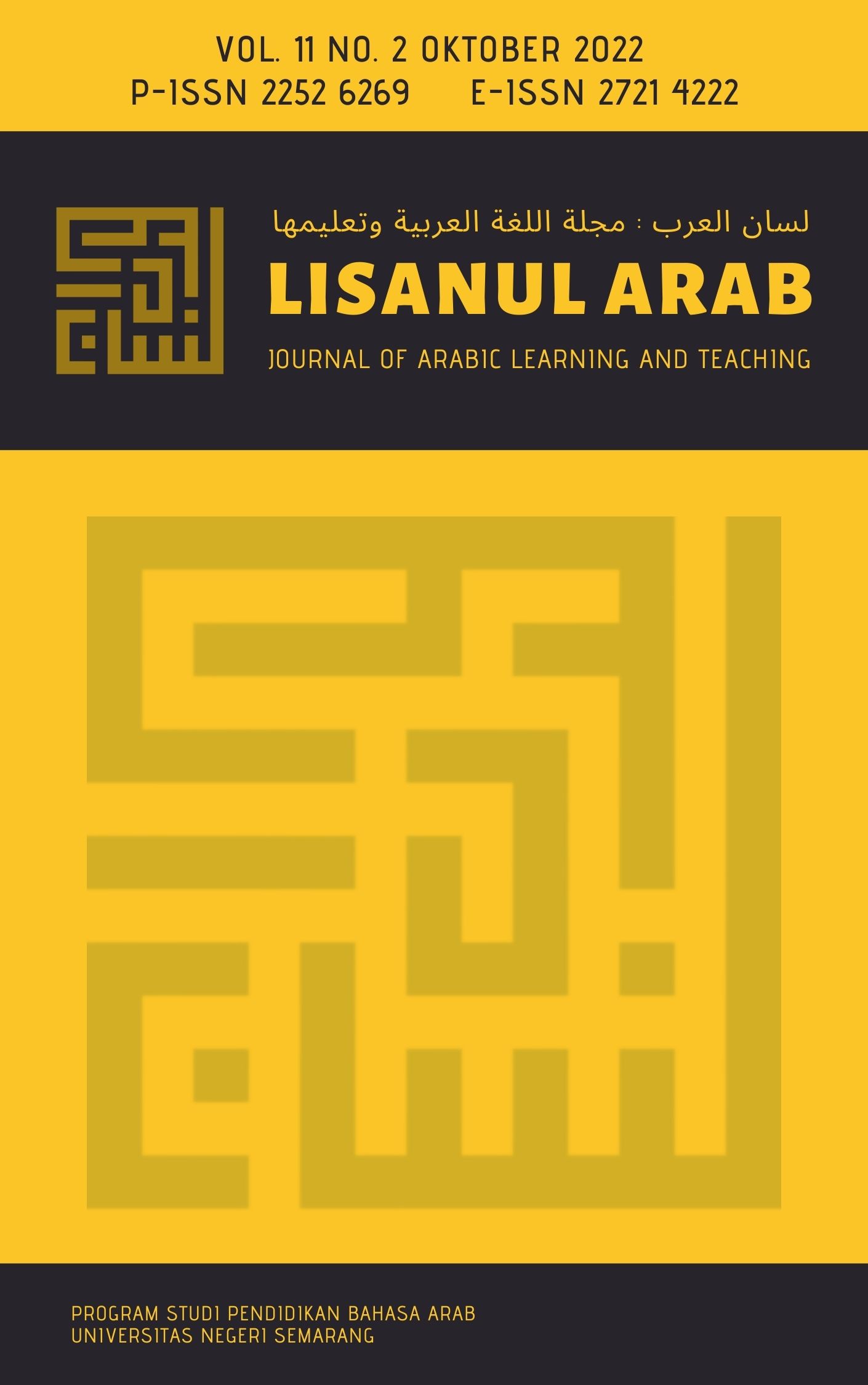TINDAK TUTUR DAN VARIASI BAHASA DALAM FILM WADJDA SEBUAH ANALISIS SOSIOPRAGMATIK SPEAKING ACTIONS AND LANGUAGE VARIATIONS IN WADJDA FILM A SOCIOPRAGMATIC ANALYSIS Section Articles
##plugins.themes.academic_pro.article.main##
Abstract
The objectives of this research are; (1) To find out the directive speech acts used in the Wadjda film; (2) To find out the atmosphere of use, the means of use, who the speakers/users are, the field of use, and the area of use as language variations related to the stigma of Arab ethnicity in the Wadjda film. This research is qualitative research, the research design is in the form of a literature study, the data collection technique is a free-talk-free listening technique, the research instrument uses data cards and data recapitulation sheets, while the data analysis method uses an informal presentation method. In this study, 237 directive speech act data were found which were divided into 55 forms of order; 86 forms of rule; 11 forms of ruling in negation form; 44 forms of advising; 19 forms of pleading; and 22 forms of recommending. The language variation that is highlighted in this study is the variation in terms of female speakers because this film is set in the social background of women's lives in Saudi Arabia.
##plugins.themes.academic_pro.article.details##
References
Hasnah, Y. (2019). BAHASA ARAB STANDAR ANTARA ’ᾹMMIYYAH DAN FUSHᾹ. Al Fathin, 2, 79–94.
Hermawan, A. (2018). Diglosia Bahasa Arab. Ta’lim al-’Arabiyyah : Jurnal Pendidikan Bahasa Arab Dan Kebahasaaraban, STAI Al-Azhary CIanjur, 2(2), 141–152.
Jarrah, S. S., & Kamel, A. A. (2012). Attitudes and practices of school-aged girls towards menstruation. International Journal of Nursing Practice, 18(3), 308–315. https://doi.org/10.1111/j.1440-172X.2012.02032.x
Kuswardono, S. (2013). علم اللغة الاجتماعي .
Masruri, H. (2015). BAHASA ARAB ’AMIYAH (Percakapan Sehari-hari untuk Haji, Umrah, TKI, Turis, dan Traveller ke Saudi Arabiya dan Sekitarnya) (A. N. Kawakip, Ed.). UIN Maliki Press.
Natsir, A., Fahrudin, A., Wahyudin, D., Setiawan, B. W., & Werdiningsih, W. (2021). KONTRIBUSI PENGETAHUAN ASBABUNNUZUL DALAM PENGEMBANGAN MATERI AL-QURAN DAN HADIS DI MADRASAH ALIYAH. Dinamika Penelitian: Media Komunikasi Penelitian Sosial Keagamaan, 21(01), 65–81. https://nasional.republika.co.id/berita/q27y3v415/polemik-pencabutan-materi-
Nugrawiyati, J. (2014). PENGGUNAAN VARIASI BAHASA DALAM PEMBELAJARAN BAHASA ARAB. Penggunaan Variasi Bahasa, 246–269. http://ejournal.kopertais4.or.id/mataraman/index.php/washatiya/article/view/2001/1481
Nugrawiyati, J. (2016). Variasi Bahasa, Media Pembelajaran Bahasa Arab. UIN Maulana Malik Ibrahim Malang, 246–269. [email protected]
Nursahid, R., Abdussalam, A., & Fakhruddin, A. (2015). PROGRAM PEMBELAJARAN TILAWAH AL-QURAN PADA PONDOK PESANTREN AL-QURAN AL-FALAH CICALENGKA BANDUNG (Studi Deskriptif tentang Program Pembelajaran Tilawah Al-Quran Tahun 2015). Program Pembelajaran Tilawah Al-Quran TARBAWY, 2(2), 92.
Prayitno, H. J. (2017). STUDI SOSIOPRAGMATIK. Muhammadiyah University Press.
Putri, T. D., Wardhana, D. E. C., & Suryadi. (2019). TINDAK TUTUR DIREKTIF PADA NOVEL BIDADARI-BIDADARI SURGAKARYA TERE LIYE. Jurnal Ilmiah Korpus, III(1).
Saifudin, A. (2019). TEORI TINDAK TUTUR DALAM STUDI LINGUISTIK PRAGMATIK (Issue LITE). Universita Dian Nuswantoro.
Santoso, B. (2017). Bahasa Dan Identitas Budaya. Sabda : Jurnal Kajian Kebudayaan, 1(1), 44. https://doi.org/10.14710/sabda.v1i1.13266
Sudiarjo, A., Mariana, A. R., & Nurhidayat, W. (2015). Aplikasi Pembelajaran Ilmu Tajwid, Waqaf dan Makharijul Huruf Berbasis Android. JURNAL SISFOTEK GLOBAL, 5(2), 54–60.
